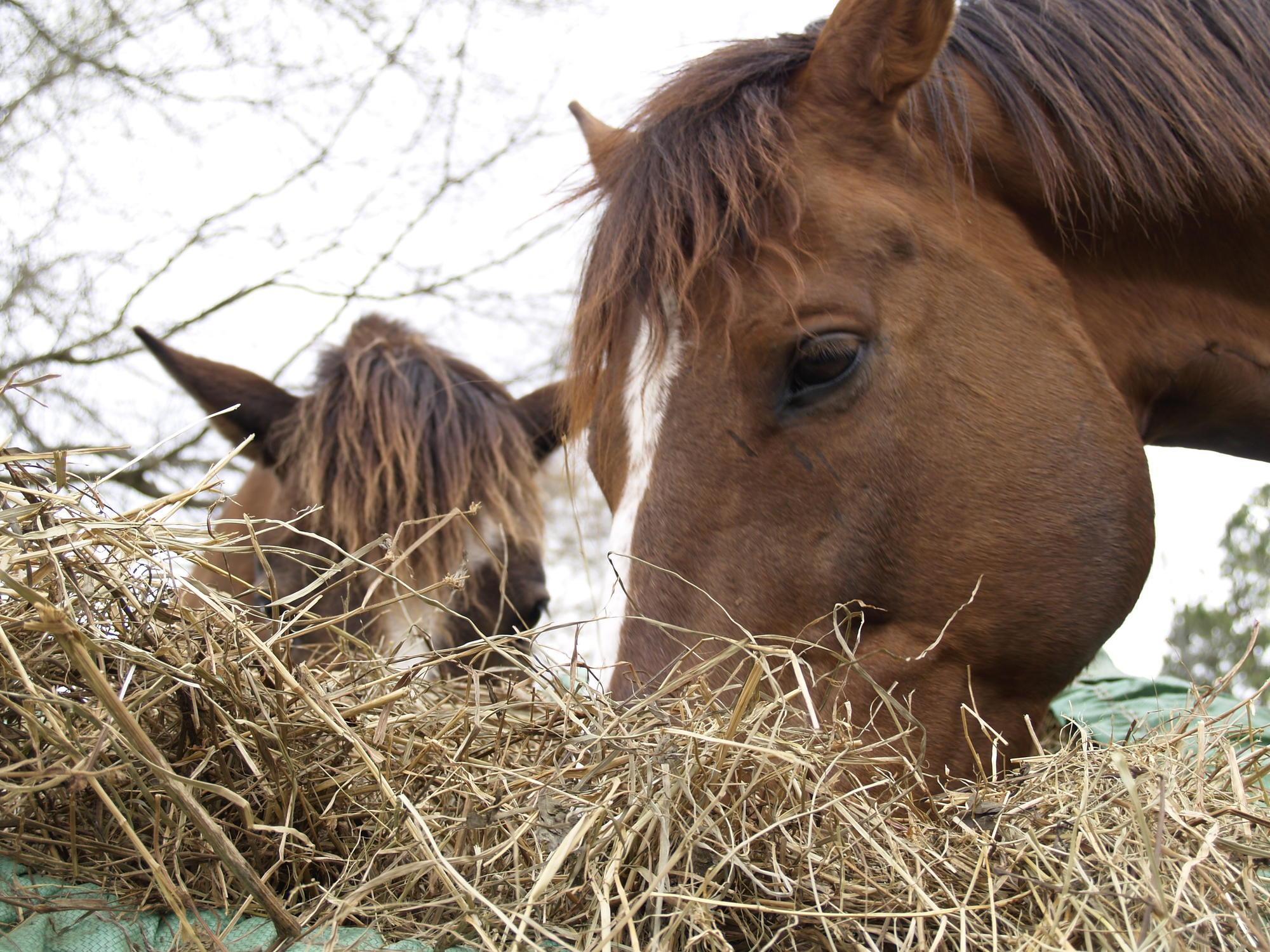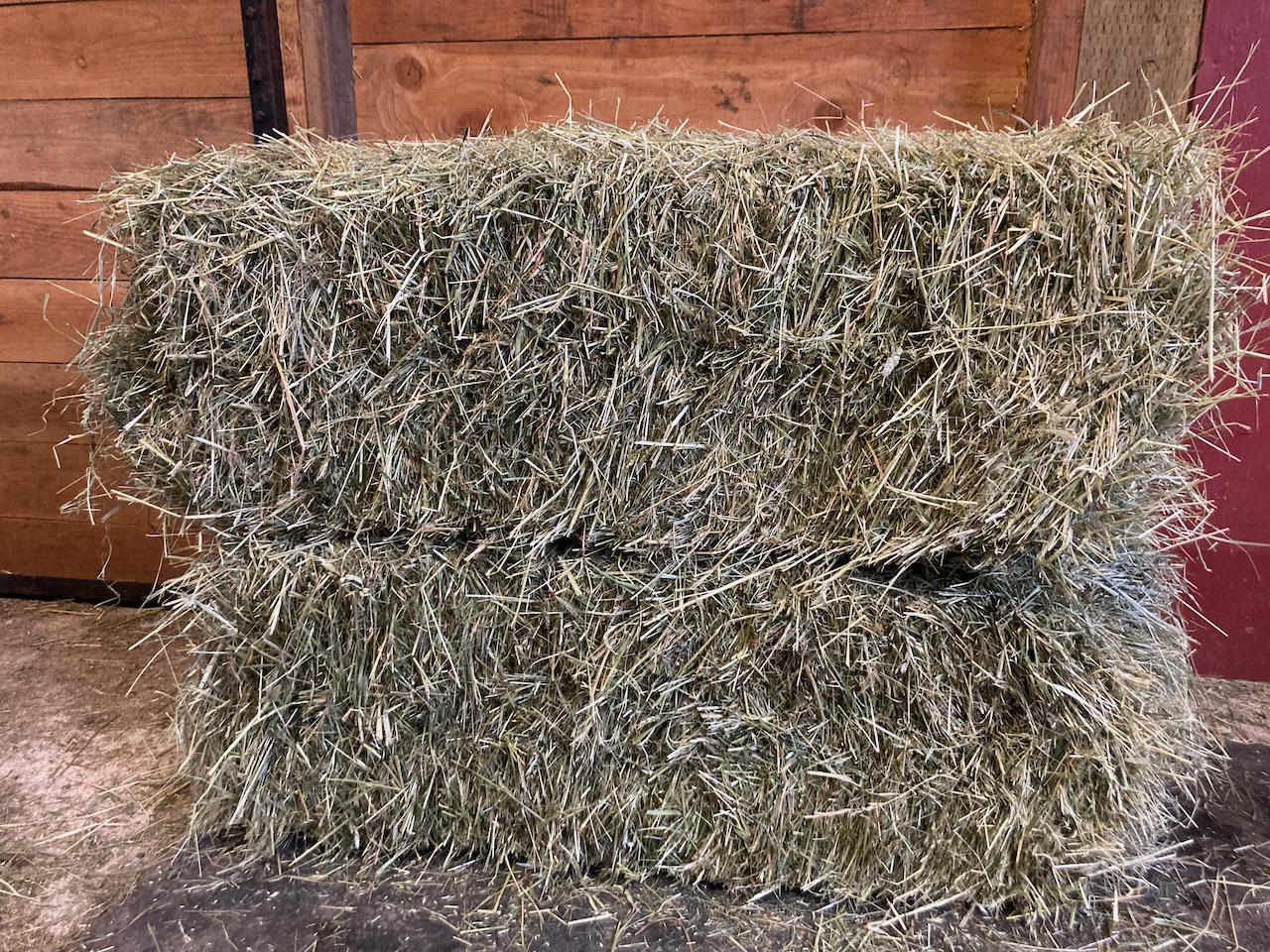Introduction
When pasture is limited or unavailable, a horse's diet is mostly roughage, normally alfalfa or grass hay. Therefore, horse owners must know how to evaluate and buy good-quality hay. Evaluating hay quality will help you spend your feed bill dollars effectively. This publication describes the horse's digestive system, nutrient requirements and methods of evaluating hay.
The horse's digestive system
To buy good hay and meet a horse's nutritional needs, you must understand the horse's digestive system. The digestive system comprises a single, small-capacity (2- to 4-gallon) stomach; the small intestine (the main site of absorption for carbohydrates, proteins and fats); and the large intestine, which includes the cecum and the large and small colon. The cecum is a large pouch of roughly 7–10 gallons.
Because of the small capacity of the stomach and the lack of a ruminant digestive system, good-quality hay is important. The nutritional requirements of horses performing heavy to intense work cannot be satisfied by forage alone. However, roughage is essential for proper digestive function.
Although horses have small-capacity stomachs and digest fiber less efficiently than cattle, feed moves rapidly through their digestive system. Most feeds pass from the mouth to the cecum within one hour. If a feed is not readily digestible, the horse will not obtain enough nutrients.
The horse's nutritional requirements
A horse uses feed for maintenance, growth, reproduction, work or adding fat. Maintenance requirements are those needed to maintain a nonworking horse at normal activities without weight gain or loss.
You can find suggested nutrient levels for horses at various stages of development in the printed National Research Council publication Nutrient Requirements of Horses or in the online tool based on that reference.
Age, weight and use of a horse influence the amount and quality of feed it needs. However, all horses need sources of energy, protein, vitamins and minerals.
Energy
Pasture and good-quality hay can supply the energy requirements for the maintenance of a mature horse. The harder and longer a horse works, the more energy it needs. Various concentrate feeds are available to meet this additional energy need. Weather also can influence energy needs. When the weather gets colder, energy needs increase. However, if the horse eats more than it needs for energy, it will add fat.
Some horses at risk for pasture-associated laminitis, colic, insulin dysregulation or equine metabolic syndrome require hay lower in nonstructural carbohydrates or sugars. See Understanding Sugars and Nonstructural Carbohydrates in Equine Hay and Pasture for more information.
Protein
Horses need protein for growth and lactation. Increasing a horse's work does not increase the protein requirements.
Both the quantity and the quality of protein in feed is important. For example, consider an average-size horse that will grow to weigh 1,100 pounds at maturity. As a foal, it needs about 18% crude protein (dry matter basis). A weanling requires about 16%, and an adult needs 8–10%. Crude protein is estimated from the nitrogen content of the feed.
Vitamins
Horses synthesize most vitamins through normal organ function and microbes in the large intestine. However, vitamins A and D must be supplied. Feeding fresh, green, sun-cured hay to confined horses will usually meet their vitamin A and D requirements.
Minerals
A calcium-to-phosphorus ratio of 1.2:1 is vital to a horse's good health. An imbalance in either of these minerals can result in poor use of the other and can lead to bone and joint disorders. Since alfalfa is very high in calcium and most grass hays are low in both calcium and phosphorus, the mineral supplement or choice of feedstuff often must be adjusted to provide the correct ratio of these elements.
In addition, hays of the Pacific Northwest vary greatly in selenium (Se) content. Feeds low in selenium are common in Oregon and can cause muscle problems known as "white muscle disease." If selenium deficiency is a concern, get your horse a blood selenium test and supplement its diet accordingly. The recommended selenium level in the total diet is 0.1 parts per million (one-tenth of one part per million).
Evaluating hay
Hay quality varies widely. Even hay of the same forage species grown in the same area can differ tremendously, depending upon harvesting management. Often, good-quality and poor-quality hay are sold at the same price. Know how to select good quality hay. Hay quality means hay feed value, which is what the hay provides your horse and whether it meets the horse’s nutrient requirements. Quality can be measured in three ways:
- Feeding trials
- Sensory evaluation—sight, smell and touch
- Chemical analysis
Feeding trials measure the response of live animals to a specific hay and give the most information. However, this method may be expensive, time-consuming and impractical for most horse owners—though it is often used in research studies. Still, you can buy a few bales of the hay to see if your horses eat it well before investing in a truckload.
Sensory evaluation is the most common method of evaluating hay quality but is subjective. The person evaluating the hay should consider stage of maturity, leafiness, color, foreign material and odor.
Chemical evaluation or forage testing provides the most accurate, in-depth nutritional information. However, it may not identify foreign matter, odors or other factors that make hay unpalatable.
A combination of visual and chemical analysis is the best way to determine hay quality.
Sensory evaluation
Stage of maturity
The stage of maturity refers to the growth stage of the plant at the time of cutting. Mature plants have more fiber and less protein, reducing feed quality. It is easy to identify the growth stage before cutting but more difficult after cutting. Look at the size and woodiness of the stem and the presence or absence of seed heads or blooms.
Alfalfa. During the bud stage, alfalfa has buds at the tips of the stems but no purple flower petals show. The plants are leafy, with fine, pliable stems. In early bloom, some purple flower petals appear and the stems are larger. After blossoming, the stems are large and woody, with fewer leaves.
Alfalfa hay is of highest quality in the bud to early bloom stage. The number of blossoms in alfalfa is not always a reliable measure of the stage of maturity of hay. Alfalfa will bloom profusely under some conditions and sparingly under others. Check the fineness of stems and the abundance of leaves.
Clovers. In the pre-bloom stage, no flowers are visible. The stems are pliable and the leaves abundant. During full bloom, blossoms emerge. Any seeds are small and soft. In full maturity, the plants have brown heads with full, plump seeds, and the stems are large and hard. Clovers are best cut for hay at the quarter- to half-bloom stage.
Grasses. In the vegetative stage, the plants are primarily leaves, with few stems. There is no sign of seed head inflorescence (flower clusters).
During early to middle heading (boot stage), the stems begin to swell with the seed head, and the flower clusters begin to emerge. During flowering (anthesis), the seed heads emerge completely, and the flowers open and shed pollen. Mature grasses have completely emerged seed heads with newly formed seeds. The leaves are brownish, and the stems are yellowish brown.
For optimal yield and quality, grasses should be cut in the early- to medium-heading stage when the seed head is just emerging from the leaf sheath.
Grasses often are cut at a later stage than desirable for high-quality hay, since delayed cutting increases the yield. For higher-quality hay and the greatest number of pounds of digestible nutrients per acre, cutting grass before anthesis is the best method. Alfalfa-grass mixes should be cut when the alfalfa is ready (early bloom). Clover-grass mixes should be harvested when the grass is in the boot or early heading stage.
Leafiness
Since two-thirds of the plant's protein is in the leaves, leafiness is an important factor for evaluating hay. The more mature the plant, the fewer its leaves. Alfalfa ranges from 10% to 15% leaves in poor-quality hay to 50% to 60% leaves in good-quality hay.
Leaf shatter is the loss of leaves due to improper curing and handling of hay. This problem is more critical in legumes than in grass because legumes lose their leaves more easily. Leaf shatter also reduces the value of the hay; if the leaves are loose in the bale, they are not held on the stems when fed to the horse and are often wasted.
As grass matures, leaves begin to yellow and die back, leaving coarse stems with few green leaves.
Highest-quality hay will be pliable and not brittle; therefore, the leaves will stay attached to the stems when the bale is broken open for feeding.
Color
The best color of hay is bright green, like that of fresh alfalfa, grass, or clover. This color indicates that the hay was cut early and cured carefully. It also shows the presence of carotene, a vitamin A.
Color variations. Light golden-yellow hay is sun-bleached; only the outside edge of the bale is yellow. The inside is still green. This hay is acceptable for feed.
Hay that is yellow throughout the bale means that the grass was overly mature when it was cut. This is relatively lower-quality, less-palatable hay, but with occasional supplementation can meet the needs of pleasure horses.
Brown hay is caused by heating and fermentation damage from being stored in a damp place. This hay has a musty odor, and the bale may be "caked." Hay of this type is unacceptable for feed. Dark brown or black hay is moisture-damaged or improperly cured. The stems are harsh and brittle, making them unacceptable for feed. Loss of bright green color means loss of carotene, possibly from rain damage, which results in leaching of other nutrients. Stored hay will not retain its carotene content for more than a year.
Foreign material
Foreign material is anything that does not belong in the hay. It can be either harmful or harmless.
Harmless foreign material is anything that doesn't belong in the hay but will not hurt the horse. This includes less desirable grass or legume species, weeds, sticks or small amounts of dirt.
Harmful matter is anything that, if eaten, can injure the horse. This includes poisonous weeds like tansy ragwort or larkspur, injurious plant parts like sandburs, grasses with sharp awns, like foxtail, or dangerous objects, including wire or nails.
Try to buy weed-free hay. Weed seeds can have potentially toxic effects and may pass through the horse and contaminate your pasture. The hay should also be free from insects and disease organisms. An example is the blister beetle, Epicauta lemniscata (Figure 2). These beetles swarm and may become baled with the hay. They are extremely toxic to horses and have been known to kill a horse overnight.
The blister beetle is fairly common in the South and Southwest of the United States. It is only occasionally found in Oregon-grown hay. Blister beetles are associated with grasshopper infestations. For more on blister beetles, see Blister Beetle Management in Forages and Field Crops.
Odor
Good-quality hay should smell like new-mown hay, not musty, mildewed or rotten. Put your nose into the middle of a bale and sniff well. If you come out sneezing and coughing, think of what it will do to your horse.
Chemical analysis
Many commercial laboratories and universities in the Pacific Northwest will chemically analyze forage samples. Many of these laboratories use a standardized hay-quality test administered by the National Forage Testing Association. Check to see that the laboratory you select is participating in this program by visiting www.foragetesting.org—it is your assurance that their analyses are reliable.
Sampling
For the lab tests, you need to obtain 20 12- to 18-inch core samples or cubes from each lot of hay. A lot is defined as hay that comes from the same cutting or field and is handled in the same fashion. There are many types of hay probes and one may be available to borrow from your county Extension office. The core samples should be taken horizontally and from the center of the bale. The bales should be selected randomly so that the sample is not biased.
For cubes, select 40 random cubes (for lots of 200 tons or less). The samples should be sealed in a plastic bag immediately so that they don't dry out. Do not subsample the sample you have taken: send the entire 20 cores or 40 cubes to the laboratory. Check with your local Extension Service office to learn if they have a hay core probe you can borrow or rent.
Laboratory tests
A variety of tests can be performed at the lab. The National Forage Testing Association recommends the moisture, crude protein, acid detergent fiber and neutral detergent fiber tests. The moisture test simply determines the amount of water in the hay and allows the laboratory to express the other tests on a standard dry-matter basis. Crude protein is a measure of the nitrogen present in the forage. This value is important in balancing the ration for protein. Acid detergent fiber is the fiber that remains after treating the forage with an acid detergent. The greater the amount of fiber left in the sample, the less digestible the forage. Neutral detergent fiber is the fiber that remains after treating the forage with a neutral detergent. Because of its bulk, higher percentages of neutral detergent fiber are associated with lower feed intake.
Test values
Average chemical analysis figures for legume and grass hays are provided in Table 1. Although chemical analysis is slower and more expensive than sensory appraisal of hay, it is more accurate and can be used to balance rations with the help of a nutritionist or sources of information. A combination of visual and chemical analysis is the best way to determine hay quality. Learn more about hay test results by reading: Understanding Your Forage Test Results.
| Type of hay and stage of maturity | Crude protein (%) | Acid-detergent fiber (ADF) (%) | Neutral-detergent fiber (NDF) (%) | Digestible energy (DE) (Mcal/lb DM) |
|---|---|---|---|---|
| Grass hay | ||||
| Immature/vegetative | 18 | 31 | 50 | 1.07 |
| Mid-maturity/early heading | 13 | 37 | 58 | 0.98 |
| Mature/heading | 11 | 42 | 69 | 0.93 |
| Legume hay | ||||
| Immature/pre-bloom | 21 | 29 | 36 | 1.19 |
| Mid-maturity/early bloom | 20 | 33 | 43 | 1.1 |
| Mature/full bloom | 18 | 40 | 51 | 1 |
Adapted from NRC 2007.
Species of hay
Almost any type of hay can be fed to horses. Some of the more popular species include alfalfa, timothy, orchardgrass, clover and oat hay. Barley hay and straw, unless from a hooded or awnless variety, should not be fed to horses because the "beards" or awns may lodge in the gums and cause abscesses.
You can supplement part of a horse's diet with grass straw. Although lower in protein and energy than most legumes or grass hay, it may actually be higher in nutrient content than overly mature, poorly handled grass hays. Grass seed straw may come from plants infected with a fungus called endophyte, which can produce compounds toxic to horses. Test tall fescue and ryegrass straw for endophytes and associated toxins.
Read Endophyte Toxins in Grass and Other Feed Sources: Risks to Livestock for more information.
Crude protein content of grass straws varies widely, from 1.25% to 11.8%. Some species such as turf-type perennial ryegrass and tall fescue have higher crude protein levels. If you plan to include grass straw in your feeding program, have it chemically analyzed and use it only as part of your horse's diet, properly supplemented with protein, energy, minerals and vitamins.
Forms of hay
Hay can be purchased in various forms, including baled, pelleted and cubed. The most common of these is square-baled hay, with grass hay bales averaging 40 to 80 pounds and alfalfa bales somewhat heavier than grass, averaging 110 pounds.
Both pellets and cubes can be fed to horses. With processed hays, daily intake will increase and less will be wasted. Both forms are more expensive than baled hay; pellets generally cost about 50 percent more to feed. Also, pellets don't satisfy a horse's need to chew. Feeding a grass straw with the pellets could overcome this problem.
Hay may also be put up in large, 1-ton bales and large, round bales. However, these require special handling equipment.
Conclusion
Hay, which often makes up a considerable portion of a horse's diet, can vary greatly in quality. As a horse owner, you should consider the quality of the hay you buy before considering the price. A good-quality hay is a better buy; although it may be more expensive initially, you will use less to satisfy your horse's needs, with less waste.
Learn more
Watch: How to Evaluate and Judge Hay and Forage
Read: Choosing Hay for Horses:
References
National Research Council, Nutrient Requirements of Horses. Sixth Revised Edition (Washington DC: National Academy Press, 2007).
Vough, L. R., H. P. Adams, and H. W. Youngberg, Feeding Grass Straw to Cattle and Horses, Oregon State University Fact Sheet 234 (Corvallis, 1976).
Acknowledgments
The authors would like to thank the contributors to a previous version of this publication: Terri Wickwire, Peter J. Ballerstedt, and Donald Holtan all formerly of Oregon State University.






